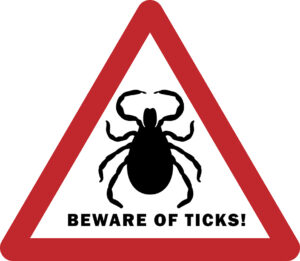Protect yourself and your family from Lyme disease
By Deborah Jeanne Sergeant
 Deer ticks, also known as black -legged ticks, can carry and transmit the bacteria that cause Lyme disease.
Deer ticks, also known as black -legged ticks, can carry and transmit the bacteria that cause Lyme disease.
The illness was named for Lyme, Connecticut, where it was first identified in the US.
Unless tick bite patients infected with Lyme are treated early with antibiotics, the disease causes patients to experience swollen knees, paralysis, skin rashes, headaches and severe chronic fatigue.
Late-term use of antibiotics is not always as effective.
Not every tick transmits Lyme disease. Still, avoiding deer tick bites can prevent infection. Once the weather reaches above 40 degrees F., ticks can emerge. The New York State Department of Health states that deer ticks are most active from April through mid-May and also in early fall.
It may seem like it would be easy to spot a tick on your leg, but Matthew Hanggi, registered nurse and Ontario County Public Health’s communicable disease control coordinator, said that nymphal ticks are the size of a poppy seed.
Unlike fleas, crawling is the only way that ticks move.
“They crawl toward a host or hitch a ride when humans, deer, mice, chipmunks, et cetera brush up against the grass, leaves and weeds of their preferred habitats, which are shady, moist areas from ground level to more than 24” above the ground,” Hanggi said.
He encourages people who spend time outdoors to:
• stay in the center of hiking trails
• tuck their pants into their socks
• wear light-colored clothing (this makes ticks easier to see)
• apply Picaridin or DEET when entering wooded areas
• physically check for ticks when leaving those areas
Although it should not be applied directly to the skin but on clothing, backpacks and footwear, permethrin can help deter ticks.
“It lasts about a month, though some clothing purchased from LL Bean, REI and other companies comes pre-applied and can last longer,” Hanggi said.
Keep permethrin away from cats. While it is wet, it’s highly toxic to cats.
Another monthly tick prevention is providing dogs with prescription parasite medication such as Simparica Trio, which guards against ticks, fleas and heartworm. Check the animal’s fur, especially between the toes and behind the ears, for ticks after time spent outdoors.
“Protecting pets is good for the animal and good for humans as it prevents them from carrying ticks into the house or bed if shared,” Hanggi said. “Allowing pets to sleep in your bed certainly adds to the risk quotient.”
After spending time outdoors, take a good shower. It takes ticks 24 hours to crawl to where they typically like hiding, such as in a bodily crevice or above the hairline. Hanggi also advises placing clothing in the dryer on high heat for 10 to 15 minutes.
“Ticks are more susceptible to dry conditions than they are to cold,” he said. “The act of drying at high heat will kill any ticks on clothing.”
Although we tend to think of picking up ticks while hiking, the encroachment of wild animals near homes can mean simply gardening in the flowerbed can expose homeowners to ticks. Hanggi has read case reports of people picking up a tick while walking to their mailbox.
He recommended installing fencing, moving wood piles and bird feeders toward the edges of the property and keeping grass cut short. Keep children’s play equipment in sunny areas and away from the property edges where overgrowth is typical.
“There are professionally applied pesticide options folks can apply to lawns to control ticks, but these can be expensive, detrimental to lake health and have diminished effectiveness if many of their neighbors don’t undertake similar actions,” Hanggi said.
Keep wildlife away from the home by minimizing attractants like food, water and shelter. Leaving out pet food and water bowls invites wildlife to help themselves and bring along ticks. Block off any cracks where critters can crawl into outbuildings.
Challis Mathes, diagnostician for Cornell Cooperative Extension Monroe County, said that the organization’s agents do not test ticks for Lyme but can identify what type of tick residents find on themselves or their pets. Have ticks tested at locations listed at https://nyticks.org/.
“If you go to the doctor and say you had a tick, they’ll give you an antibiotic,” Mathes said. “It’s pretty high likelihood of preventing Lyme if you catch it soon enough.”
He said that older adults tend to have tick bites more often than younger people, likely because they generally do not shower as often.
Mathes encourages people to leave opossums alone and to not shoo them from their property.
“Opossums are our friends; they eat an incredible number of ticks each year,” he said. “Their body temperature is very low for a mammal. They tend to not carry rabies. I don’t think there are any records of them carrying rabies. They’re relatively harmless.”
Chickens, ducks and guinea fowl are also natural tick predators.

